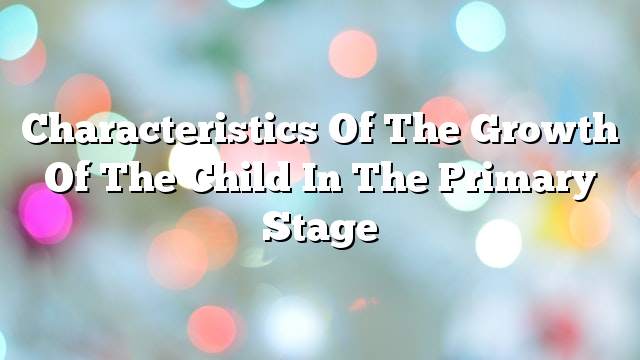Child growth
Growth is a cumulative process that evolves according to the age of the individual. It is also influenced by the individual genetics and nature of life, which includes food, environment and culture. In addition, the growth of the individual in each life stage is characterized by characteristics that distinguish it from growth in the rest Stages. In this article we will learn about the characteristics of the child’s growth in primary school.
Characteristics of the growth of the child in the primary stage
Growth in the primary stage is characterized by several characteristics, which are distributed according to certain patterns.
Characteristics of motor growth
The child in the primary stage has several characteristics in terms of its motor development, as follows:
- Control the pen hold, and thus have full control over the writing.
- The desire to spend his own needs, and to make new things.
- The strength of his body has generally doubled, due to his increased energy.
- To ensure efficiency and proficiency in the performance of his work, especially in manual work.
Characteristics of sensory growth
The sensory growth of the individual in the primary stage is characterized by several characteristics, including:
- Ability to distinguish musical melodies, due to increased hearing accuracy.
- Eliminate the length of vision, which helps him to do business near him, and pay more attention.
- The development of sensory perception, and thus increase the child’s ability to know time, and events in sequence.
- The development and improvement of the muscles of his body, and thus the practice of handcraft with high comfort.
Characteristics of mental growth
The mental development of the individual in the primary stage is characterized by several characteristics, including:
- The development of reading skills, thus increasing the child’s desire to read stories and magazines.
- The growing ability of the individual to invent, and the invention of machines and devices, commensurate with his thinking and age.
- Increase the intensity of attention to the things surrounding him, in addition to the increase in duration, and not to break his mind quickly.
- The ability to distinguish between correct and erroneous behavior, commensurate with age.
- Prepare to learn complex materials, suited to older individuals.
- Growing curiosity and curiosity, and the desire to discover more.
- Ability to observe and evaluate the actions of others, and their actions in person.
Characteristics of emotional growth
The emotional growth of the child at this stage characterized by several characteristics, including:
- The abstraction of childhood, and the sense that it has become large and large.
- Adjusting his emotions and emotions, and increasing his ability to control his actions.
- Distinguish between happy and sad news, and interact with it with laughter or sadness.
- To follow new ways of expressing his feelings, expressing jealousy with sarcasm, and his anger with contention.
Characteristics of social growth
Characteristics of the growth of the social individual in the primary stage include the following:
- The ability to deal with older individuals and integrate into society.
- He was very impressed by his peers and his team.
- Ability to take responsibility, control behavior and conduct.
- Make friends of the sex of the individual, and not to mix with the other sex in friendship and play.
